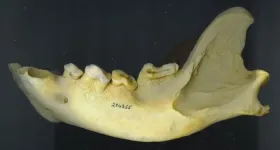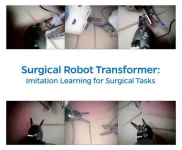(Press-News.org) A new study led by Dr. Jack Tseng and published in PeerJ Life & Environment has shed light on the intricate relationship between tooth wear and jaw mechanics in highly carnivorous mammals, known as hypercarnivores. As mammalian teeth do not regenerate, these animals often face declining bite efficiency as their teeth wear down over time. This research explores how different hypercarnivorous species, including scavengers, meat specialists, and bone-cracking predators, adapt biomechanically and possibly behaviorally to manage the challenges posed by tooth wear.
The team examined three representative carnivoran ecomorphologies: meat specialists like big cats, scavengers, and bone crackers, such as spotted hyenas. By analyzing morphofunctional data, including jawbone depth, bite efficiency, and jaw stress during biting, the study investigated whether these animals’ mandibular biomechanics show compensatory changes as their teeth become worn.
Key findings revealed that, among the species studied, only bone-cracking hyenas displayed significant increases in bite efficiency with tooth wear, maintaining performance without added jaw stress. Conversely, meat specialists and scavenging hyaenids did not demonstrate significant biomechanical compensation for tooth wear, suggesting that these groups may rely more on behavioral modifications to secure and process food.
Dr. Tseng’s team also explored the extinct carnivore Hyaenodon, a species thought to have feeding adaptations similar to modern hyenas. Interestingly, Hyaenodon showed increased bite efficiency with worn teeth, though the researchers believe this adaptation may be driven more by species-specific evolutionary pressures than by life history.
"Once grown, adult teeth in living mammals are irreplaceable and have to last their entire lives. For top predators that rely on their teeth to acquire and process food, we wondered if changes in feeding performance from dental 'wear and tear' were compensated for by how the jaw mechanically resists stress from biting. We discovered that living predators and the extinct Hyaenodon may have used different biomechanical strategies to compensate for worn teeth.” explains Dr. Tseng.
This study invites scientists to revisit the way we assess carnivore guilds, past and present, and highlights the dynamic relationship between evolutionary adaptations and life history stage in the animal kingdom.
END
New study reveals unique adaptations of jaw function and tooth wear in hypercarnivores
2024-11-11
ELSE PRESS RELEASES FROM THIS DATE:
Robot that watched surgery videos performs with skill of human doctor
2024-11-11
A robot, trained for the first time by watching videos of seasoned surgeons, executed the same surgical procedures as skillfully as the human doctors.
The successful use of imitation learning to train surgical robots eliminates the need to program robots with each individual move required during a medical procedure and brings the field of robotic surgery closer to true autonomy, where robots could perform complex surgeries without human help.
“It’s really magical to have this model and all we do is feed it camera input and it can predict the robotic ...
“Emotional contagion” a factor in senior’s mental health
2024-11-11
Madeleine and Paul are sitting on a park bench. As she tells Paul about her financial worries and how she’s been struggling for months to make ends meet, Madeleine’s eyes well with tears. Paul is moved by her distress; her woes resonate with him and heighten his own fears. His heart grows heavy and his own eyes become moist, too.
What’s going on? A kind of behavioural mirroring, what psychologists call “emotional contagion.”
“Just as some people are more likely to catch a respiratory virus through close contact, others are more susceptible to ‘catching’ the emotions of the people around them,” explained Marie-Josée ...
Fear of another heart attack may be a major source of ongoing stress for survivors
2024-11-11
Research Highlights:
Fear of another heart attack was a significant ongoing contributor to how heart attack survivors perceive their health, according to a new study.
While anxiety and depression are recognized as common conditions after a heart attack, they did not explain the impact of fear of recurrence in this study.
The researchers suggest that fear of another heart attack should be evaluated and addressed separately from depression and anxiety.
Note: The study featured in this news release is a research abstract. Abstracts presented at the American ...
Let’s talk about sex: Heart patients want guidance from health care professionals
2024-11-11
Research Highlights:
A small survey of adults aged 30 to 89 (average age of 65) in Sweden who have heart conditions found that there is a significant difference between the sexual health information they seek and what is provided to them by their health care professionals and the health care system.
Despite 76% of patients with heart conditions reporting that sexual health affects their mood and well-being, only 5% received information or counseling about sexual health.
Researchers suggest health care professionals adjust their patient care practices to ensure that discussing sexual health becomes a standard and respected topic in health ...
Heart disease more common in past redlined areas linked to limited access to healthy foods
2024-11-11
Research Highlights:
Heart disease, Type 2 diabetes, high blood pressure and obesity were more common and linked to reduced access to healthy food among people who lived in neighborhoods previously subjected to structural racism-based policies that limited home ownership — an outlawed practice known as redlining.
Researchers say testing interventions to help improve access to healthy food or boost social and economic resources could mitigate the still-present impact of outdated policies like redlining.
Note: The study featured in this news release is a research abstract. Abstracts presented at American Heart Association’s scientific meetings are not peer-reviewed, and the ...
Heart disease could hit up to 28 years sooner for people with CKM syndrome
2024-11-11
Research Highlights:
Scientists conducted a simulation study to estimate the impact of cardiovascular-kidney-metabolic (CKM) syndrome on cardiovascular disease (CVD) risk prediction.
The study found that adults with chronic kidney disease would have elevated CVD risk eight years earlier than those without the disease. In addition, people with Type 2 diabetes would have an elevated CVD risk about a decade sooner than those without it.
Among adults with both Type 2 diabetes and chronic kidney disease, women ...
MESA heart disease risk score worked well with or without race included
2024-11-11
Research Highlights:
A version of the Multi-Ethnic Study of Atherosclerosis (MESA) heart disease risk score that did not include race predicted heart disease risk just as well as the original version that includes race.
The original MESA risk score, developed in 2015[1], combines traditional risk factors, sex and race with a coronary artery calcium score.
The MESA formula without race may be used for people who identify with more than one racial or ethnic group or those who prefer not to disclose their race or ethnicity.
Note: The study featured in this ...
Bystander CPR up to 10 minutes after cardiac arrest may protect brain function
2024-11-11
This news release contains updated information and data not included in the abstract.
Research Highlights:
The sooner a lay rescuer (bystander) starts cardiopulmonary resuscitation (CPR) on a person having a cardiac arrest at home or in public, up to 10 minutes after the arrest, the better the chances of survival and brain protection, according to an analysis of nearly 200,000 out-of-hospital cardiac arrest cases in the U.S. from 2013 to 2022.
Among the study’s findings, people who received CPR within two minutes of out-of-hospital cardiac arrest had 81% higher odds of survival to release from the hospital ...
911 dispatcher assistance improved chances of receiving bystander CPR
2024-11-11
Research Highlights:
A study of nearly 2,400 cardiac arrest cases in North Carolina found that when emergency dispatchers (telecommunicators) provided cardiopulmonary resuscitation (CPR) instructions to 911 callers, people were more likely to provide aid for both men and women.
The study’s findings indicate that when a telecommunicator provided assistance to callers, bystander CPR was performed 44% of the time on women and 40% on men, compared to 9% on women and 11% on men when telecommunicator assistance was not provided.
Researchers found the telecommunicator role critical in instructing bystanders to act quickly, possibly instrumental in reducing sex disparities ...
GLP-1, SGLT2 medications may lower stroke survivor’s risk of future heart attack, stroke
2024-11-11
Research Highlights:
In an analysis of more than 7,000 stroke survivors, those who were taking either a GLP1-receptor agonist or an SGLT2 inhibitor medication had a lower risk of a subsequent stroke, heart attack or death compared to peers who were not prescribed the medications during a three-year follow up period.
The analysis used health data from the Rochester Epidemiology Project collected from 2000 to 2022. The first GLP-1 medication was prescribed beginning in 2006, and the authors included cases beginning in 2000 to increase the power of the study, they noted.
Note: The study featured in this news release ...

